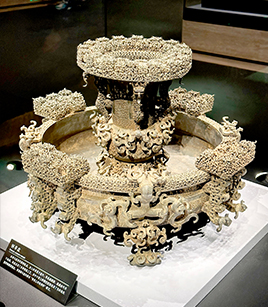Marquis Yi of Zeng’s Zun and Basin

Marquis Yi of Zeng’s Zun and Basin Photo: Ren Guanhong/CSST
The Tomb of Marquis Yi of Zeng was discovered in Hubei Province in 1978. Yi was thought to be the ruler of the Zeng State in the early Warring State Period (476–221 BCE). An astonishing collection of burial objects has been found in his tomb, including a set of bronze bells of different sizes and pitch sequences weighing nearly five tons. Another set of bronze vessels also stands out with its peculiar design and advanced casting techniques. It is known as Marquis Yi of Zeng’s Zun and Basin.
This is a set of wine vessels consisting of a bronze zun and a bronze pan [a basin]. A zun was used to contain wine while pan held water, which could be used to warm or cool the wine. They are individual pieces yet designed to be a perfect match. The height of the zun is 30.1 cm, with a diameter of 25 cm. The pan is 23.5 cm high, with a diameter of 58 cm.
This set was probably not made for practical uses, because its functional parts are covered in delicate decorations. The mouth of the zun is covered with multi-layered hollow decorations, which from a distance resemble clouds, but is actually a hollowed-out texture composed of intertwined dragons and snakes. On the neck of the zun, there are four leopards crawling upwards, their bodies also decorated with hollowed-out dragons and snakes. The belly and feet of the zun are decorated with pan-chi [hornless dragons] motifs and dragon reliefs. The pan was made more sophisticated.
Archaeologists have agreed that this set represents the highest quality and the most advanced technique of bronze artifacts in the Warring States Period. There has been debate on how such a masterpiece was created. It is said that a man spent twenty years making a full-scale replica using a technique called lost-wax casting. However, the replica is still far from the original in terms of exquisiteness and verve.
Edited by REN GUANHONG

 PRINT
PRINT CLOSE
CLOSE